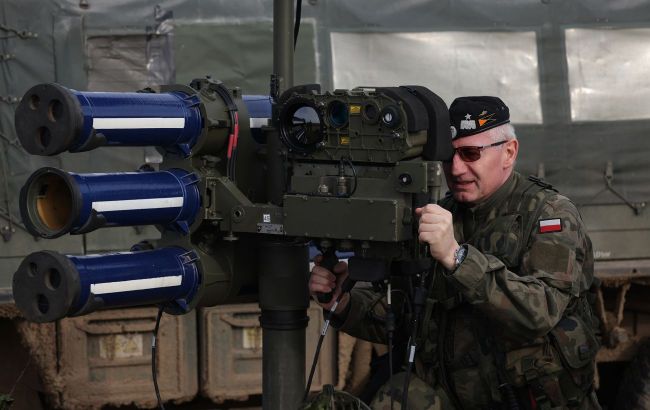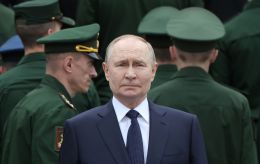Closing the skies: Will NATO dare to shoot down Russian drones and missiles over Ukraine
 Polish Brigadier General Piotr Fajkowski sights targeting system of LML short-range air-defense system during NATO's "Brilliant Jump" drills (photo: Getty Images)
Polish Brigadier General Piotr Fajkowski sights targeting system of LML short-range air-defense system during NATO's "Brilliant Jump" drills (photo: Getty Images)
Is NATO ready to shoot down Russian targets over Ukraine? What are the positions of individual Alliance members — and what would it take to turn that idea into reality? Read the full piece by RBC-Ukraine.
Key questions:
• Why has the idea of shooting down Russian drones and missiles over Ukraine resurfaced?
• What are the technical details of such an initiative?
• Who is for — and who is against — shooting down targets over Ukraine?
Over the past week, several of Ukraine's neighbors have been directly affected by Russian aggression. On September 10, about twenty Russian drones entered Poland; on September 13, a drone crossed into Romania. On September 15, a drone hovered over government buildings in Warsaw for several hours. These incidents have been a major test of NATO’s practical response and cohesion.
The United States has largely stepped back from this — President Donald Trump publicly suggested the attack on Poland might have been accidental. However, European NATO members have already deployed additional forces to Poland to patrol the skies and will draw on Ukrainian experience in fighting drones. Moreover, the idea of shooting down Russian targets over Ukraine — before they can reach NATO countries — has reentered public debate.
"This situation shows that finally the decision needs to be taken to enable partner air defense capabilities in neighbouring countries to be used to intercept drones and missiles in the Ukrainian airspace," Ukrainian Foreign Minister Andrii Sybiha wrote on X on September 10.
His Polish counterpart, Radoslaw Sikorski, later said the idea deserves consideration.
"Protecting our population, for example, from falling debris, would naturally be better if we could engage drones and other flying objects outside our national territory," Sikorski told Frankfurter Allgemeine Zeitung.
The initiative may sound straightforward, but there are many political and purely military details and nuances to work through.
Libya – yes, Ukraine – no
The idea of shooting down Russian drones and missiles over Ukraine is nothing new. Back in the first days and months of Russia’s full-scale invasion, President Volodymyr Zelenskyy made desperate appeals to the West to close the skies over Ukraine to stop Russian strikes on civilian infrastructure.
At that time, Ukraine's air defense system had suffered heavy losses and lacked the means to intercept ballistic missiles like the Iskander-M, which Moscow frequently used in the early months of the war.
NATO has done this before — but in other conflicts. No-fly zones were introduced in 1991 to protect friendly forces and civilians in Iraq after the Gulf War, during the breakup of Yugoslavia in Bosnia and Herzegovina in 1993–95, and in Libya during the civil war in 2011. But in all those cases, the allies were up against much weaker opponents.
In the case of Ukraine and Russia, it would mean protecting the skies from a nuclear power. NATO — and above all, the United States under Joe Biden — lacked the political will. Then-NATO Secretary General Jens Stoltenberg explained that such a decision could trigger a direct military conflict with Russia, potentially escalating to nuclear war.
The Atlantic Council think tank noted that enforcing a no-fly zone over Ukraine would require massive deployments of F-22 and F-35 fighters across the country, suppression of Russian S-300 and S-400 systems, and would likely cause significant NATO losses — not to mention the humanitarian risk of creating a false sense of safety while Russian artillery attacks continued. NATO, therefore, chose indirect support: supplying Ukraine with air defenses and training its forces.
The downside of that approach is that NATO members themselves have gained little to no practical experience in intercepting air targets. Meanwhile, the nature of the war has shifted — drones of all kinds now play a central role.
This became clear during the September 10 drone attack on Poland, when the combined efforts of several NATO countries managed to shoot down only four out of around twenty UAVs. As a result, Polish troops will now train with their Ukrainian counterparts on drone defense.
In response to the Poland incident, NATO is planning to strengthen its Baltic Air Policing mission, which patrols the skies over Lithuania, Latvia, and Estonia. The alliance has also launched Operation Eastern Sentry to bolster air defenses along NATO's eastern flank. Eight countries—France, Germany, Czechia, the UK, Denmark, Italy, Spain, and Sweden—have already joined or signaled their intent to participate. In practice, this means reallocating air defense assets to the most threatened areas.
"Eastern Sentry will be flexible and agile, delivering even more focused deterrence and defense exactly when and where needed. It will include additional enhanced capabilities. It will integrate air and ground-based defenses, and it will increase information sharing amongst nations," Alexus Grynkewich, US European Command and NATO Supreme Allied Commander Europe, said on September 12.
For now, NATO stresses it is not considering a full no-fly zone — even over part of Ukraine. But with the expansion of operations in this direction, the alliance is only one step away.
Technical details
Almost everything is ready for NATO assets to shoot down aerial targets over Ukraine. Most of Ukraine's air defense is Western-made. Accordingly, information-sharing protocols are identical, which will make coordination relatively simple.
"From a military point of view it could look like this: aircraft, say taking off from Polish territory, could engage and shoot down Shahed drones or missiles in western regions of Ukraine that are heading toward Poland or other European countries," Oleksandr Saienko, commander of the 67th Brigade in 2022–2023 and now a military analyst at the Independent Anti-Corruption Commission (NAKO), told RBC-Ukraine.
At the same time, he said, conducting combat missions jointly is a fairly complex process and must be practiced. However, Ukraine and NATO have extensive experience holding military exercises, so this should not pose a problem.
NATO air-defense and aviation can also shoot down targets without entering Ukrainian airspace. On one hand, that reduces political risks; on the other, it significantly limits the effectiveness of such actions.
From the territory of Poland and other western neighbors of Ukraine, it is effective to intercept only Russian missiles — using expensive missiles carried by F-16s, F-35s, or Eurofighter Typhoon aircraft, and air-defense systems such as Patriot, NASAMS, and SAMP/T. Using these systems to shoot down drones is economically impractical.
As Ukrainian experience has shown, cheaper means are more effective for destroying drones: short-range SAMs and mobile fire teams, interceptor drones, and helicopters. Poland, in particular, will follow this path. On September 15, Radoslaw Sikorski reported that Ukrainian instructors will train Polish teams to counter Russian drones. But all these means have a limited range and can operate only on the territory of their own states, at most in the border zone.

French military personnel observe a Rafale B fighter at the Mińsk Mazowiecki air base, Poland (Photo: Getty Images)
So far, Russia has launched only drones toward NATO countries. But there have been several cases when missiles briefly entered NATO airspace and later struck targets in Ukraine very close to the border. Given that such incidents have been increasing recently, the Alliance should also be prepared for direct missile strikes on its territory.
In that case, the discussion concerns operations over the western and southern regions of Ukraine at most. Among the air-defense means available to Ukraine's neighbors, the longest reach belongs to the Aegis Ashore ballistic-missile defense system, which can intercept ballistic missiles at ranges up to 200 km. Patriot systems deployed in Poland and Romania also have a maximum range of about 160 km against cruise missiles.
The situation is worse when it comes to shooting down ballistic missiles. The surface-to-air missiles for Patriot — the MSE, designed to counter that type of threat — have a shorter range of up to 40 kilometers. That seriously narrows the protective capability of the systems if they are deployed on the border with Ukraine.
"Even if we cram the borderline with these Western complexes, they will only be able to protect the Yavoriv training ground from ballistic missiles. There are no other facilities that can protect our partners' complexes in this area: neither Lviv, nor Stryi, nor Ivano-Frankivsk," aviation expert Kostiantyn Kryvolap previously said.
In any case, to shoot down targets over Ukraine from abroad, or to operate directly over Ukrainian airspace, proper legal authorization is required, Saienko emphasized.
"The bigger problem here is the legal side — permission for units of Poland or another country to be on Ukrainian territory. That requires a request from the president to the Verkhovna Rada," the expert said.
In his view, that step should be taken now as a forward-looking signal to partners, and the best format of cooperation in such a case would be a separate bilateral agreement with Ukraine. Among other things, it should include provisions on possible damages and casualties that may result from actions by foreign forces in Ukraine.
Neighbors' political will
Among Ukraine's western neighbors, the only real candidates to take part in air operations over Ukraine are Poland and Romania. The others maintain a more ambiguous stance.
Hungary, under Viktor Orbán, and Slovakia, led by Robert Fico, have expressed solidarity with Poland but avoid direct criticism of Russia and are not ready to escalate tensions with Moscow. Formally neutral Moldova has not stated its position at all, but is preparing to legalize the downing of unidentified drones in its airspace.
Romania and Poland face somewhat different domestic political circumstances, which could affect decision-making. In Warsaw, a key factor is the rift between Prime Minister Donald Tusk and President Karol Nawrocki, analyst Vitalii Diachuk of the Institute for Central European Strategy and Re:Open Ukraine told RBC-Ukraine.
"At the moment, Poland will need some kind of consensus, because most likely the decision will have to be made by the government, while the president may hold a separate view," Diachuk noted.
Despite Foreign Minister Radoslaw Sikorski's statement about downing targets over Ukraine, no final decision has been taken. But at least on the level of political rhetoric, there has been no strong resistance to the idea from Poland's head of state. Marcin Przydacz, head of the International Policy Bureau of the President’s Office, recently stopped short of mentioning downing targets over Ukraine but announced plans for cooperation with Kyiv.
"We plan close cooperation with Ukraine on an effective anti-drone shield at the border. This should serve as a buffer against the escalating threat of Russian attacks," Przydacz said on Radio ZET.
According to Lukasz Adamski, deputy director of the Mieroszewski Center and a Polish foreign policy expert, all responsible politicians and experts in Poland understand the need to respond firmly to Russia's September 10 drone provocation — otherwise, such incidents will continue.
"The question is what political and military instruments to use to ensure that the response is painful for the Russian regime, but at the same time does not increase the risk of Poland's direct involvement in the war," Adamski told RBC-Ukraine earlier.

Patriot missile launcher near Constanța, Romania (Photo: Getty Images)
Meanwhile, Romania has said it does not currently plan to shoot down targets over Ukraine. In recent years, Russian drones have also regularly crossed into Romanian territory, though not on the same scale as in Poland.
"We have held preliminary discussions on this issue with people from the national state apparatus, advisers, the military, and foreign policy experts. For now, the answer is rather no. But depending on how events develop, we may revisit this decision,” Romanian President Nicușor Dan said on Antena 3 on September 16.
Ultimately, NATO’s willingness to support Ukraine's neighbors will be decisive. Their own forces may meet Alliance standards, but they remain limited.
NATO is waiting
Speaking about the prospect of intercepting targets over Ukraine, Radoslaw Sikorski noted that Warsaw would need the support of the entire NATO alliance as well as the European Union.
"We, as NATO and the EU, could do this, but Poland cannot make this decision on its own; it can only be taken jointly with its allies," Sikorski said.
In this case, it is more about political considerations rather than direct restrictions from NATO, Victoria Vdovychenko, co-lead on our Future of Ukraine Program at Cambridge University’s Center for Geopolitics (UK), told RBC-Ukraine.
"If Poland believes that drones over Ukrainian territory pose a threat to it, then it can shoot them down in coordination with Ukraine using the means it already has at its disposal. If they were to operate other systems stationed on Polish territory, then yes, an Alliance decision would be required," Vdovychenko said.
Securing support from NATO allies may be more significant than it seems at first glance. For example, in the downing of drones over Poland on September 10, Dutch F-35 Lightning II fighters, Polish F-16 Fighting Falcons, German and Italian Eurofighter Typhoons, a Swedish Saab 340 early warning and control aircraft, and even an Airbus A330 MRTT air refueling tanker were involved. Most importantly, they were coordinated and integrated into a single air and missile defense system (NATINAMDS).
For now, however, NATO remains silent. On September 12, Secretary General Mark Rutte was asked directly about this in the context of Operation Eastern Sentry, but he avoided giving a clear answer, only stressing NATO's defensive role.
"What this (Operation Eastern Sentry - Ed.) shows is that we will defend every inch of NATO territory, every inch of Allied territory, all 32 Allies... We are in a defensive Alliance, not an offensive Alliance,” Rutte said.
Most NATO members have not yet stated their position. Still, such an initiative is likely to be seen as risky in the United States or Germany. In addition, Donald Trump has recently avoided taking sharp steps toward Russia.
Politically, NATO faces an old dilemma: how to ensure the inviolability of its borders without triggering a conflict with Russia, which has already issued fresh threats. Just days ago, Russian Security Council Deputy Chairman Dmitry Medvedev declared that implementing such an initiative would mean a "NATO war with Russia."
Ultimately, NATO's stance could shift as the Kremlin continues to test the Alliance's resolve. After the weak response to the attack on Poland, such a scenario has become almost inevitable.
Sources: statements by Ukrainian and European politicians, publications from the Atlantic Council, the Center for European Policy Analysis, Breaking Defense, and commentary from Oleksandr Saienko, Vitalii Diachuk, Victoria Vdovychenko, Kostiantyn Kryvolap, and Lukasz Adamski.

